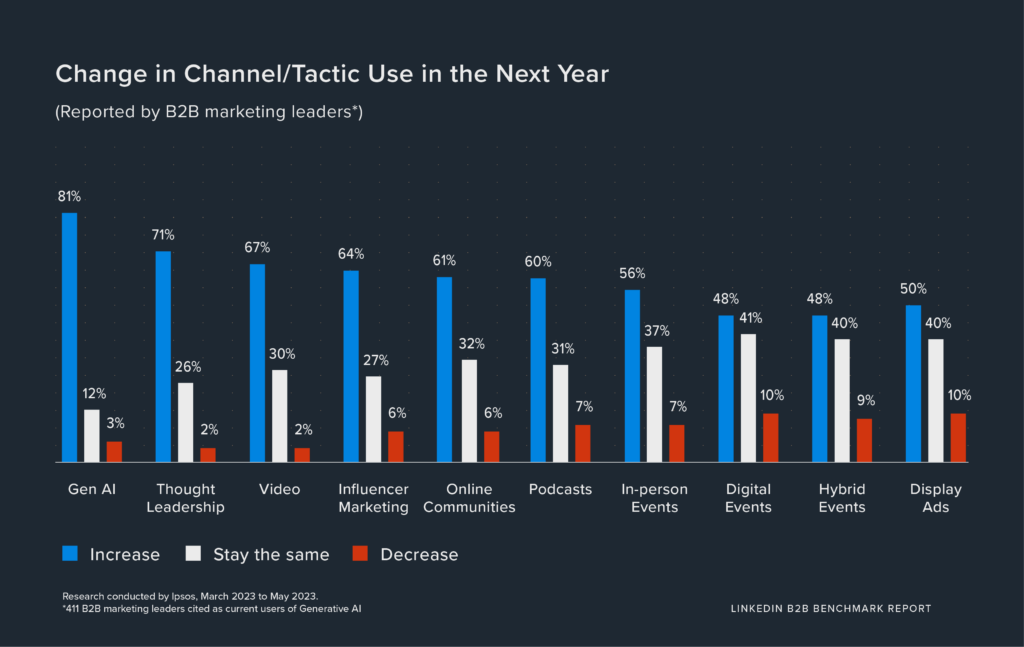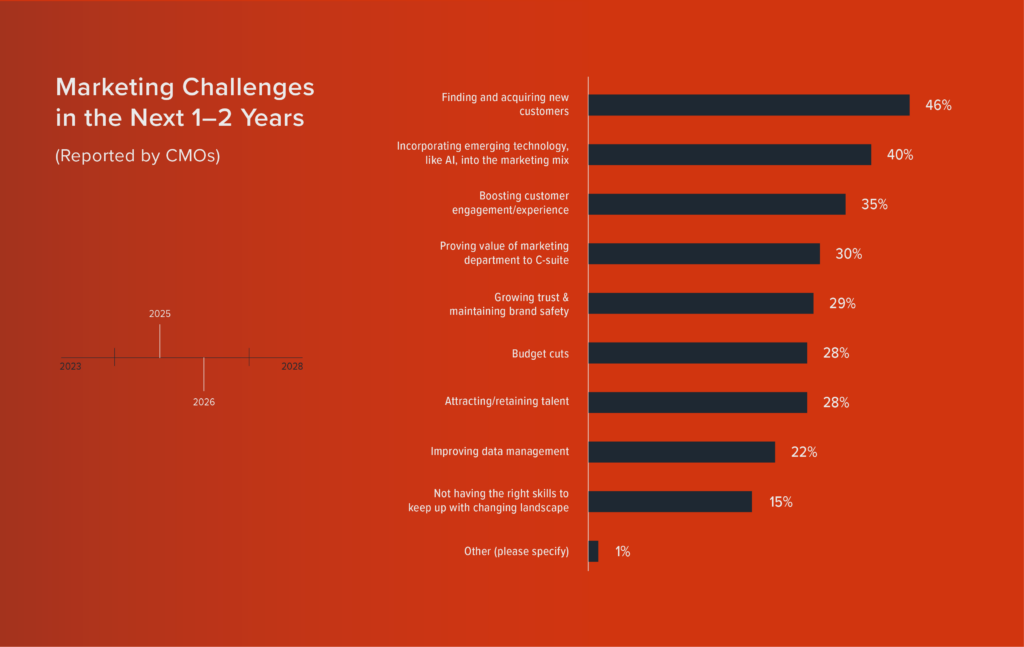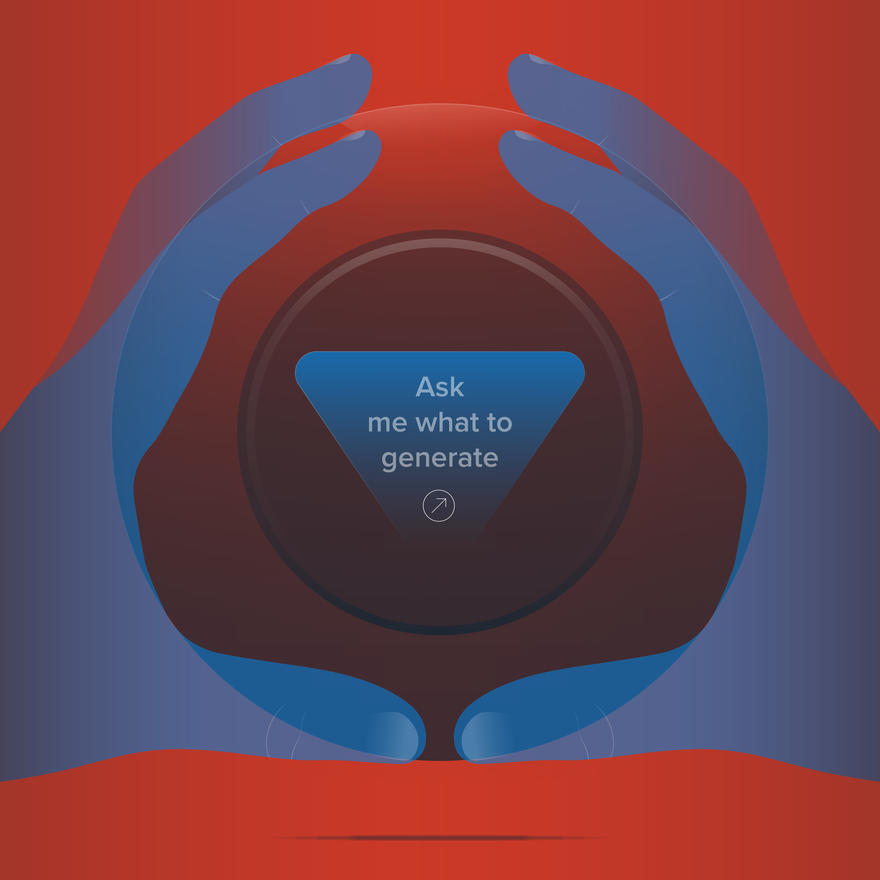Let’s face it: we live in an era where artificial intelligence (AI) permeates every aspect of our lives. Since 2012, there’s been a millionfold increase in AI’s computation capacity, doubling every three to four months, and LinkedIn has seen a 143% increase in AI-related posts in the last year alone. AI fever has taken over.
From the operating systems in our phones to the complexity of global communications, AI drives the systems that are vital to the modern world. Whether we’re ready or not, we now walk hand-in-hand with each new iteration of its technology and are profoundly affected by the evolving policies and debates around its widespread use.
Nowhere are these debates more real than in advertising, where the recent craze of Generative AI (GenAI) and a growing awareness around AI-driven automation in the C-suite has thrown today’s marketers into flux about the future of their careers. 51% of marketing and advertising professionals fear they could lose their jobs to AI. But how real are these fears? Will marketers ever become replaced?
In short, no, but we’ll get to that.
Leading from the front
CMOs are busy. We get it. The pressure to stay ahead of trends, competitor strategies, market factors, and evolving technologies can be exhausting—all of this while trying to preserve and grow your brand’s value with both employees and customers.
Ultimately, it’s this gap between a CMO’s limited time to execute strategic plans and the demand for improved marketing outcomes that makes AI such an attractive tool. Most notably, AI’s enhanced production capabilities through GenAI and campaign automation drive rapid adoption by marketing leadership. LinkedIn reports that 3 in 4 B2B marketing leaders say they plan to start or continue using GenAI in their marketing operations in the next year.

It’s one thing to adopt a tool, but CMOs first need to ask the question: “How do I effectively implement it into my organization? What are the benefits, limitations, and risks?”
Adoption is fast; implementation takes time (and expertise).
Here’s our advice for those ready to make the leap:
- Trust In Expert Partnerships – Implementing AI in your marketing operations requires careful planning, investment in infrastructure, training, and ongoing oversight. Unfortunately, CMOs rarely have the personnel or resources needed to manage its implementation and outputs in-house. In fact, less than 2 in 10 report they have an extremely good understanding of how to use AI. Even if they do, rolling it out without proper training presents significant risk. As competitors increasingly adopt AI tools, delaying can mean falling behind. Partnering with experts who can efficiently and responsibly handle AI technology is essential for staying competitive.
- Embrace AI’s Creative Potential – As a CMO, inspire your team and partners to view AI as a tool for innovation and empowerment, fostering a culture of opportunity rather than fear. Recent research by Adobe shows 80% of Americans believe GenAI will help them be more creative, and over 50% think it can help them learn new skills faster. Employees and partners should see AI as a tool to enhance their work, not replace them. AI will not supplant human creativity in advertising; like all automation before it, it will only enhance our ability to work more efficiently and collaboratively, driving greater progress.
- Monitor, Test, and Track Impact – Though AI can produce cost efficiencies, we’re not just talking about tracking the bottom line. According to McKinsey, more than 20% of digital marketing budgets are invested in AI-related technologies. GenAI, in particular, can shorten production timelines, create timely variations of assets for A/B testing, and optimize campaigns through precise targeting and personalization. This iterative process helps refine the AI models faster, producing even greater ROI over time, and providing actionable optimizations across the whole of your marketing strategy.
Balancing AI’s creative potential with its challenges
As an agency, we strive to stay at the forefront of creativity, offering our clients top-tier solutions to their marketing challenges. We intentionally explore and test AI to see how it can make our processes more efficient, placing us at the intersection of AI technology and the creative process. This approach enables us to leverage AI effectively, producing innovative and award-winning outcomes for our CMO partners. While we recognize that AI provides powerful tools and opportunities, it also comes with its own set of challenges. We commit to continually learning and adapting to keep up with the rapid advancements in AI, ensuring we effectively integrate its strengths while navigating its limitations.
GenAI is revolutionizing the creative landscape across media. Here are some key areas where it’s making an impact, along with insights into its potential limitations:
- Audio: Advancements in voice recognition technology, coupled with GenAI, can reproduce unique tonal patterns and inflections, or even generate human-like voices for use in video voice-overs, podcasts, and more. By pairing GenAI with large language models (LLMs) and neural machine translation (NMT), experts predict that future AI audio tools could achieve near-human parity. However, there are notable limitations to consider. AI-generated voices often struggle with capturing the full emotional range of a conversation, nuanced expression, pauses for breath, and cultural fluency that can create problematic issues across translation, bias, and representation efforts. Ethical issues can arise as well, particularly when synthetic voices replicate real individuals without consent.
- Video: AI video technology can help enhance the storyboard design and post-production processes. At present, most generative videos are used on high-frequency, lower-end channels, like social media, due to their simpler production scope. But that won’t be the case forever: 59% of global B2B CMOs report that video is one of their biggest investments in the year ahead. Future applications in virtual reality (VR), augmented reality (AR), and extended reality (XR) will only enhance the need for AI to intuitively generate immersive experiences tailored to real-time user feedback. That said, CMOs should note that AI videos struggle with achieving the level of detail and realism that human-driven production can provide. Additionally, AI video editing tools can sometimes introduce inconsistencies or artifacts that require human intervention to correct, increasing costs where they should create efficiency. Challenges also encompass ethical concerns surrounding deepfakes, AI-generated videos that can convincingly mimic individuals or events, raising issues of authenticity and trust. Additionally, there exists a perception that AI-generated content may lack the authenticity and impact of human-created content, potentially influencing how audiences perceive and engage with the brand.
- Imagery: AI retouching and generative fill tools can help speed up photo editing to achieve a desired aesthetic without extensive manual effort. Time-intensive tasks such as blemish removal, color correction, and creating realistic backgrounds — filling in missing elements or extending images beyond their original borders — enable photographers and designers to focus their creativity on more complex edits. However, AI-generated enhancements may occasionally produce unnatural results or miss subtle nuances that a skilled human editor would capture. It is crucial for photographers to carefully oversee and review results to ensure the integrity and artistic intent of their work remain uncompromised.
- Campaigns: Agencies have always leveraged AI to build efficient, targeted, and optimized marketing campaigns. The rise of GenAI tools presents new opportunities for enhanced personalization, testing, and adaptive creative. Recently, industry leaders like Walmart, L’Oreal, and Uber have been using AI in incredibly creative ways to build lasting brand interactions, drive sales, and reinforce brand loyalty. We’ll spare you all the details; check out their impressive initiatives here. With more critical touch points managed by AI, there’s always a risk that campaigns will feel generic or fail to resonate with specific audience segments. To avoid an over-simplification of messaging and creative and prevent potentially offensive responses to human engagement, CMOs need strict oversight of campaigns to ensure their brand’s presence isn’t being reduced to the lowest common denominator.
- Research/Copywriting: GenAI processes raw information 125,000 times faster than the human mind. With this much raw power for analysis on their side, copywriters have found GenAI as an invaluable resource for reading, editing, and condensing their work. While GenAI often lacks the wit or polish of a seasoned copywriter who’s trained in human experience and the semantics of language, it can be an incredible tool for efficiency: scanning documents, reducing hour-long meetings to a series of bullet points, drafting email responses, and more. However, potential limitations around AI for copywriters include its inability to grasp nuanced cultural references, generate original creative insights, interpret sarcasm and complex humor, or understand the emotional undertones necessary for persuasive and empathetic writing. Maintaining a consistent brand voice requires careful oversight. Additionally, generating inappropriate or off-brand content is risky without proper checks.
- Workflow: In client-agency relationships, AI can help significantly streamline operational workflows. AI-driven tools can automate routine tasks such as raw data analysis, digital optimizations, content scheduling, and performance tracking on KPIs, freeing up time for more collaboration between teams to focus on creative strategy and innovation. A recent study by Salesforce found that 71% of marketing employees say generative AI will eliminate busy work, allow them to focus on more strategic work, and save them over five hours per week—the equivalent of over a month per year. While not every process can be automated without oversight, these efficiencies bring us closer to a future where the most desirable skills for marketers will be around creativity and original thought, not menial task completion.
These examples illustrate how GenAI enhances creative outputs across different media. While GenAI’s strengths are clear, it’s essential to remain mindful of the limitations. CMOs should work with their agencies to preserve the quality of their brand image and messaging while still crafting new creative and campaigns at scale.
“The mass adoption of GenAI has transformed customer and employee interactions and expectations. As a result, GenAI has catapulted AI initiatives from ‘nice-to-haves’ to the basis for competitive roadmaps.”
– Srividya Sridharan, VP and group research director at Forrester
Overcoming AI challenges and managing risks
Despite nearly a quarter-century since the first 2000s-era social media influencer burst onto our screens But all this radical innovation is not without risk. While it’s important to understand the potential of AI, it’s also necessary for CMOs to know and anticipate the challenges AI adoption poses in both a legal and ethical sense.
Here are some things to watch out for:
- Intellectual Property & Copyright – As LLMs source from larger, less protected datasets, the risk of unknowingly generating content that infringes on existing copyrights increases, raising legal questions about its impact on IP rights and exposing CMOs to risk. As recently as last year, a lawsuit with billions in damages between OpenAI and The New York Times made global headlines, with many experts expecting a Supreme Court ruling on the legal use of AI in the near future. The solution for dealing with this risk? Partner with agencies that stay up to date with the latest developments and use ethical AI tools. Through this collaboration, CMOs limit liability and ensure compliance while still leveraging the benefits of GenAI.
- Bias & Representation – Without the awareness for potential discrimination, GenAI models push the stereotypes and biases present in human thinking to extremes. In an experiment run by Bloomberg, GenAI models were asked to assign traits and job roles to a spectrum of human faces. Results showed the majority of lighter-skinned males were trustworthy and were assigned jobs as “doctors” or “lawyers” while darker-skinned men and women were “fast-food workers” or “social worker.” This outcome clearly indicated that the dataset used to train the models was significantly skewed, as it built learnings from inherent biases in the representation of different races and ethnic groups across the internet and popular media. In creating marketing content and campaigns, CMOs must be conscious of how representation factors into their AI outputs.
- Sustainability & Responsible Use – Technology’s negative impact on sustainability is not a surprise. It’s been documented for years how processing on a quantum scale requires significant natural resources to sustain. Environmental researchers found that training a single AI model would generate a shocking 626,000 pounds of carbon dioxide. For CMOs with brand positioning or initiatives around sustainability, these impacts need to be weighed to avoid the perception of false credibility regarding environmental efforts.

Closing: Embracing change with optimism
CMOs understand that with AI, as with all transformative technologies, the risk mirrors the reward. The marketing landscape is always changing, but it’s our privilege as marketing professionals to face the future head-on as confident thought leaders for our employees, customers, and partners.
By boldly embracing change and building a plan for success, you not only future-proof your operations but also inspire your teams and partners to innovate and excel. The time to act is now—not a decade from now when competitors have outpaced you and your customers have moved on.
Work with your agency partners to learn about the potential of generative AI and help lead your organization into a new era of creativity and efficiency.
To stay up to date on agency news, awards, and blog posts, subscribe to our Spire Wire newsletter.

